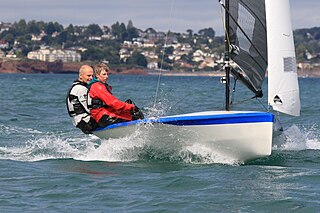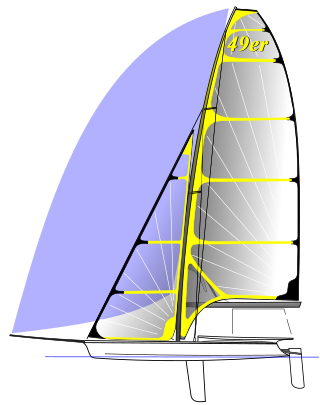
Dinghy sailing is the activity of sailing small boats by using five essential controls:

The GP14 is a wooden or fibreglass hulled double-handed fractional Bermuda rigged sailing dinghy designed by Jack Holt in 1949.

Boat building is the design and construction of boats — and their on-board systems. This includes at minimum the construction of a hull, with any necessary propulsion, mechanical, navigation, safety and other service systems as the craft requires.

A Streaker is a type of sailing dinghy designed in 1975 by Jack Holt. It is a light one-person boat with a uni-rig stayed sail plan. It is sailed mainly in Britain and the Philippines, and over 2200 have been built. At first all boats were built of plywood, but since 1998 fibreglass, and fibreglass variants have been used, and now over half of new boats are of fibreglass or composite construction.

The National 12 is a two-person, two-sail, twelve-foot long sailing dinghy. They are sailed extensively in the UK. The class was started in 1936 by the Royal Yachting Association as an alternative to the more expensive International 14s.

The 49er and 49er FX is a two-handed skiff-type high-performance sailing dinghy. The two crew work on different roles with the helm making many tactical decisions, as well as steering, and the crew doing most of the sail control. Both of the crew are equipped with their own trapeze and sailing is done while cantilevered over the water to the fullest extent to balance against the sails.

The International 505 is a One-Design high-performance two-person monohull planing sailing dinghy, with spinnaker, utilising a trapeze for the crew.

The OK Dinghy is an international class sailing dinghy, designed by Knud Olsen in 1956.

The Fireball is a British sailing dinghy that was designed by Peter Milne as a one-design racer and first built in 1962.

The 18 ft Skiff is considered the fastest class of sailing skiffs. The class has a long history beginning with races on Sydney Harbour, Australia in 1892 and later in New Zealand. The boat has changed significantly since the early days, bringing in new technology as it became available. Because of the need of strength, agility and skill, the class is considered to be the top level of small boat sailing. Worldwide this boat is called the "18 Foot Skiff". It is the fastest conventional non-foiling monohull on the yardstick rating, with a score of 675, coming only third after the Tornado and Inter 20.

The International 14 is an International racing sailboat, crewed by two sailors. The class was established in 1928.

The Merlin Rocket is a 14 foot (4.3 m) dinghy sailed in the United Kingdom. It is an active class, now with over 3800 boats built.

The Cherub is a 12 feet long, high performance, two-person, planing dinghy first designed in 1951 in New Zealand by John Spencer. The class is a development class, allowing for significant variation in design between different boats within the rule framework. The minimum hull weight was originally 110 lbs.
The P-Class is a type of small single sail dinghy, popular as a training boat for young people in New Zealand. This class is famous for being the sailing trainer vessel for many new entrants into the sport, and virtually every famous New Zealand yachtsman, including Dean Barker and Russell Coutts, learnt to sail in one. The P-Class was for many years the most common sailing boat in New Zealand.
The Bell Woodworking Seagull and Seamew are both small sloop-rigged marine ply sailing boats of the Trailer yacht type designed by Ian Proctor, who was also responsible for the design of many small sailing dinghies in seven different classes including the extremely popular Topper, and Wanderer.

The Hornet dinghy is a 16-foot-high performance dinghy designed by Jack Holt in 1952.

The Windmill is an American sailing dinghy that was designed by Clark Mills as a one-design racer and first built in 1953.

The NS14 is an Australian restricted development class of sailing dinghy. Measuring 14 feet in length, the class was designed the 1960 and introduced at the Northbridge sailing club in Sydney, Australia, with control of the class transferred to the NS14 Association of New South Wales in 1965. Subsequently the boat was introduced to the other states, prior to being taken to New Zealand in 1995 and the United States in 1998.
The Skate is a high performance two-person racing dinghy unique to Australia. Designed as a monohull sailboat it's fourteen feet long (4.27m) with a 7.2m mast, 1.8m bow pole and masthead asymmetrical spinnaker. It is an Australian national class.

The Skunk 11 is a Canadian utility dinghy that can be rowed, used as a motorboat, fishing boat or as a sailing dinghy. It was designed by Hubert Vandestadt and first built in 1969.